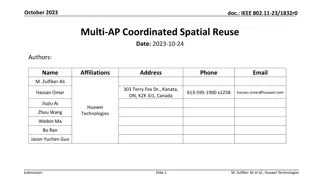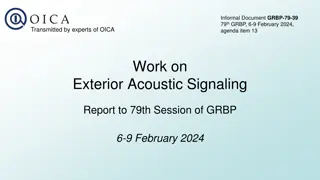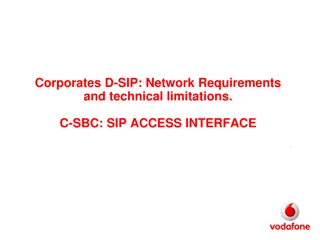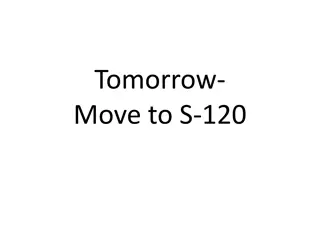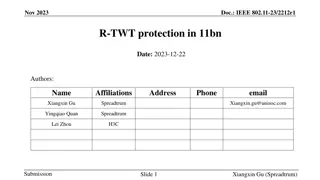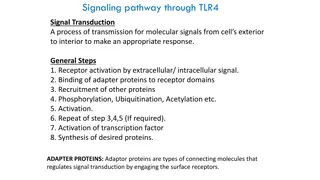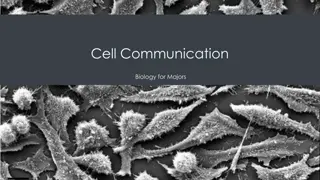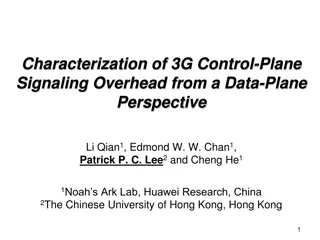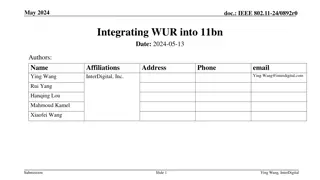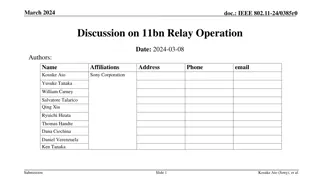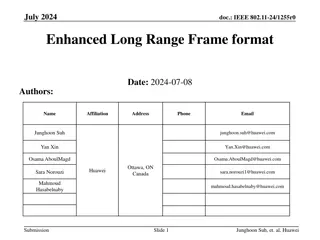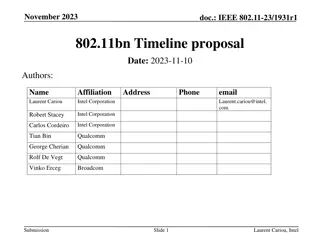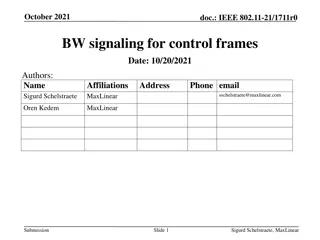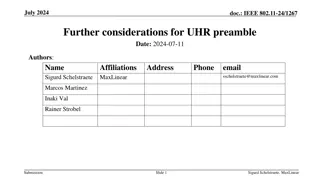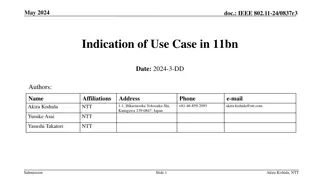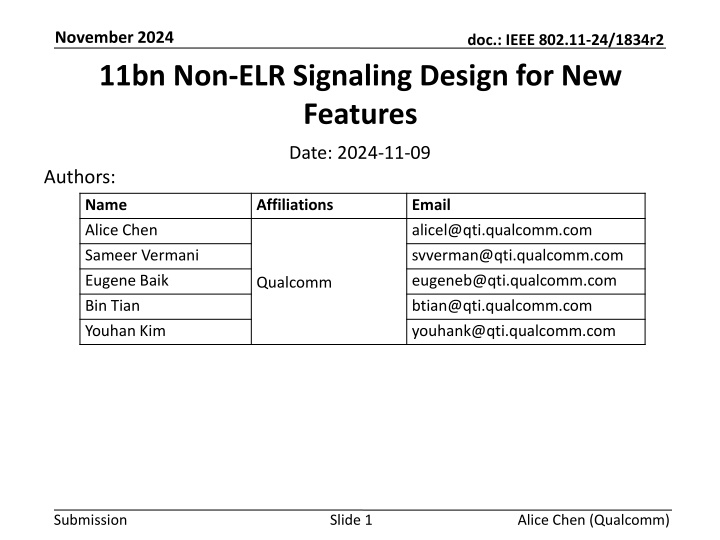
IEEE 802.11-24 U-SIG and UHR-SIG Design for New Features
Explore the design of U-SIG and UHR-SIG in IEEE 802.11-24 for accommodating new features like Multi-AP capabilities and user-specific enhancements. Delve into the signaling aspects and field structures to support these advancements effectively.
Download Presentation

Please find below an Image/Link to download the presentation.
The content on the website is provided AS IS for your information and personal use only. It may not be sold, licensed, or shared on other websites without obtaining consent from the author. If you encounter any issues during the download, it is possible that the publisher has removed the file from their server.
You are allowed to download the files provided on this website for personal or commercial use, subject to the condition that they are used lawfully. All files are the property of their respective owners.
The content on the website is provided AS IS for your information and personal use only. It may not be sold, licensed, or shared on other websites without obtaining consent from the author.
E N D
Presentation Transcript
November 2024 doc.: IEEE 802.11-24/1834r2 11bn Non-ELR Signaling Design for New Features Date: 2024-11-09 Authors: Name Alice Chen Sameer Vermani Eugene Baik Bin Tian Youhan Kim Affiliations Email alicel@qti.qualcomm.com svverman@qti.qualcomm.com eugeneb@qti.qualcomm.com btian@qti.qualcomm.com youhank@qti.qualcomm.com Qualcomm Submission Slide 1 Alice Chen (Qualcomm)
November 2024 doc.: IEEE 802.11-24/1834r2 Introduction EHT [1] has two U-SIG formats for MU PPDU and TB PPDU, respectively In UHR (when PHY Version Identifier is set to 1) [2], there will be at least three U-SIG formats for the three PPDU types MU PPDU TB PPDU ELR PPDU [3-4] Preamble in UHR MU PPDUs need some changes to accommodate signaling for new features Multi-AP features: Coordinated beamforming (CoBF), Coordinated spatial reuse (C- SR) User specific features: New MCS, spatial domain unequal modulation (UEQM), 2x LDPC Scheme related to frequency resource allocation: Interference mitigation (IM) In this presentation, we have a comprehensive discussion on U-SIG and UHR-SIG design in UHR to accommodate new features Submission Slide 2 Alice Chen (Qualcomm)
November 2024 doc.: IEEE 802.11-24/1834r2 U-SIG Overview The 2-bit PPDU Type and Compression Mode field [3-4] in U-SIG differentiates basic transmission modes Include ELR Reuse EHT NDP, as in our proposal [14] No UHR NDP UL/DL 0 (DL) 0 (DL)/1 (UL) 0 (DL) 0 (DL)/1 (UL) 1 (UL) 1 (UL) PPDU Type And Compression Mode 0 1 2 3 0 2 Transmission Mode DL OFDMA SU transmission DL non-OFDMA MU-MIMO ELR TB Validate PPDU Type MU PPDU MU PPDU MU PPDU ELR PPDU TB PPDU N/A In the following, we discuss U-SIG in UHR TB PPDUs U-SIG & UHR-SIG in UHR MU PPDUs, with signaling discussion for new features Submission Slide 3 Alice Chen (Qualcomm)
November 2024 doc.: IEEE 802.11-24/1834r2 U-SIG in UHR TB PPDUs Propose to keep the same U-SIG field structure as in EHT TB PPDUs [1] PHY Version Identifier is set to 0 or 1 to differentiate EHT & UHR [2] U-SIG Field in EHT/UHR TB PPDU Number of Bits 3 3 1 6 7 6 2 1 4 4 5 4 6 Bits Field B0-B2 B3-B5 B6 B7-B12 B13-B19 B20-B25 B0-B1 B2 B3-B6 B7-B10 B11-B15 B16-B19 B20-B25 PHY Version Identifier Bandwidth UL/DL BSS Color TXOP Disregard PPDU Type And Compression Mode Validate Spatial Reuse 1 Spatial Reuse 2 Disregard CRC Tail U-SIG-1 U-SIG-2 Submission Slide 4 Alice Chen (Qualcomm)
November 2024 doc.: IEEE 802.11-24/1834r2 Preamble Change in MU PPDUs The remaining slides focus on preamble change in MU PPDUs This part includes Signaling discussion for new features in MU PPDUs Discussion on the preamble design in the following order User field formats U-SIG UHR-SIG common field Submission Slide 5 Alice Chen (Qualcomm)
November 2024 doc.: IEEE 802.11-24/1834r2 Signaling Discussion for 2x LDPC (1/2) 2x LDPC (codeword size of 3888) [6] is likely an optional feature in 11bn Traditionally the usage of codeword size is solely based on ??????? For 2x LDPC, on top of similar way to choose the codeword size, there is additional benefit to add a signaling bit to indicate 2x LDPC (i.e., using nominal codeword size of 3888) Broadcast packets cannot use 2x LDPC if STA Rx support of 2x LDPC is optional Transmitter cannot be certain that only 2x-LDPC capable STAs will be decoding the packet Currently, no PHY signaling exists which identifies a broadcast packet Even 2x LDPC-capable receivers cannot be sure if 2x LDPC is being used in a PPDU This signaling bit also allows more flexibility in turning ON 2x LDPC for appropriate packet sizes at the transmitter Submission Slide 6 Alice Chen (Qualcomm)
November 2024 doc.: IEEE 802.11-24/1834r2 Signaling Discussion for 2x LDPC (2/2) Signaling design & Rx behavior Propose to use a 1-bit 2x LDPC subfield in user (info) fields to signal the use of the nominal codeword size of 3888 in a PPDU If the coding scheme is LDPC and this subfield indicates 2x LDPC ON (1), codeword size of 3888 is used in a PPDU If the coding scheme is LDPC and this subfield indicates 2x LDPC OFF (0), codeword size of 3888 is not used; Rx uses the existing codeword size selection procedure to choose codeword size The 2x LDPC subfield is set to 1 and treat as Validate at Rx if Coding is BCC (0) Tx Side 2x Codeword Size Selection Tx has freedom in choosing the nominal codeword size and setting the 1-bit 2x LDPC subfield accordingly Then, Tx follows the LDPC PPDU encoding parameter table [10] (motion passed) to select the nominal codeword size Note that if the 2x LDPC subfield indicates 2x LDPC OFF (0), the LDPC PPDU encoding parameter table [10] is equivalent to the existing table in 11be Submission Slide 7 Alice Chen (Qualcomm)
November 2024 doc.: IEEE 802.11-24/1834r2 Signaling Discussion for New MCS & UEQM & User Field Formats New MCS Support to use a 5-bit MCS subfield [10, 13, 18] (such as the encoding [16]) to include new MCS [5]. This change should be consistent in MU-MIMO and non- MU-MIMO user field formats as well as user info field in Trigger Frame Spatial domain UEQM (in non-MU-MIMO) Motions passed to use a 1-bit UEQM flag [11] and a 2-bit UEQM pattern subfield [13, 17] (to indicate all UEQM patterns [7-9] for each given Nss) if UEQM is ON User field formats discussion Propose the user field size to be 23 bits [13, 18] instead of 22 bits [10-12, 19] to accommodate the 2x LDPC indication and keep other fields in an elegant way Suggest to remove 1 Disregard bit in the UHR-SIG common field in non-OFDMA to keep a two symbol UHR-SIG (transmitted using MCS0) in SU transmission We like the ideas of 5-bit MCS field [10, 13, 16], 3-bit Nss field [12-13] in non-MU- MIMO, and 4-bit spatial configuration field [10-13, 18] in MU-MIMO Further propose to reuse the 4-bit 11ax Spatial configuration encoding in the MU-MIMO user field as in [14, 18] Overall, we support the user field design in [13, 18] Submission Slide 8 Alice Chen (Qualcomm)
November 2024 doc.: IEEE 802.11-24/1834r2 Signaling Discussion for Other Features CoBF In UHR, propose that CoBF is only applicable to non-OFDMA transmission There will be an indication of a CoBF transmission in U-SIG [14] (motion passed) We proposed in [14] and support [18] regarding the following signaling in preamble A 2nd BSS color (separate from the version independent BSS Color) for a 2nd AP A 1-bit indication in the MU-MIMO user field format (by repurposing the Coding bit) to differentiate the two BSSs and avoid STA ID collision Use the 11ax 4-bit spatial configuration in the MU-MIMO user field in both DL MU-MIMO and CoBF C-SR In UHR, propose that C-SR is only applicable to SU transmission in each BSS In C-SR, synchronization and common L-SIG, RL-SIG and U-SIG are desirable to make U-SIG reliable Need an indication of a C-SR transmission as well as a 2nd BSS color for a 2nd AP, similar to CoBF IM [15] In UHR, IM should be for non-MU-MIMO transmission only, at least applicable to single-BSS SU transmission Need to indicate an IM transmission, in the case of non-OFDMA Submission Slide 9 Alice Chen (Qualcomm)
October 2024 doc.: IEEE 802.11-24/1834r2 U-SIG Design in MU PPDU Design criterion: Leave at least 1 reserved bit in all cases U-SIG-2 B2 Indicates C-SR ON/OFF in SU transmission Indicates CoBF ON/OFF in non-OFDMA MU-MIMO, as in [18] Is a Validate bit in other cases Use U-SIG-1 B20-B25 to indicate the 2nd BSS Color for CoBF/C-SR, similar to [18] Otherwise, these 6 bits use same definition as in 11be, i.e., B20-B24 of U-SIG-1 are Disregard bits and B25 of U-SIG-1 is a Validate bit B0-B2 B3-B5 Bits Field Number of Bits 3 3 1 6 7 PHY Version Identifier Bandwidth UL/DL 1st BSS Color TXOP 2nd BSS Color in CoBF/CSR or same definition as in 11be in other cases PPDU Type And Compression Mode CoBF/C-SR indication Punctured Channel Information Validate UHR-SIG MCS Number Of UHR-SIG Symbols CRC Tail B6 U-SIG-1 B7-B12 B13-B19 B20-B25 6 B0-B1 B2 B3-B7 B8 B9-B10 B11-B15 B16-B19 B20-B25 2 1 5 1 2 5 4 6 U-SIG-2 Submission Slide 10 Alice Chen (Qualcomm)
October 2024 doc.: IEEE 802.11-24/1834r2 UHR-SIG Common Field Design in Non- OFDMA Use a Disregard bit B13 in UHR-SIG common field in non-OFDMA transmission to indicate Interference Mitigation (IM) ON/OFF Value 0 indicates IM enabled Value 1 indicates IM disabled (because B13 was originally 'set to 1 and Disregard at RX ) Further, remove 1 Disregard bit to have 19 bits in the common field and keep a two symbol UHR-SIG (transmitted using MCS0) in SU transmission Non-OFDMA Bits B0-B3 B4-B5 B6-B8 B9 B10-B11 B12 B13 B14-B15 B16-B18 Field Number of Bits 4 2 3 1 2 1 1 2 3 Spatial Reuse GI+LTF Size Number Of UHR-LTF Symbols LDPC Extra Symbol Segment Pre-FEC Padding Factor PE Disambiguity IM indication Disregard Number of Non-OFDMA Users UHR-SIG Common Submission Slide 11 Alice Chen (Qualcomm)
November 2024 doc.: IEEE 802.11-24/1834r2 Summary Discussed signaling for new features Multi-AP features: CoBF, C-SR User specific features: New MCS, spatial domain UEQM, 2x LDPC Scheme related to frequency resource allocation: IM Presented our thoughts and proposal in U-SIG and UHR-SIG design Submission Slide 12 Alice Chen (Qualcomm)
November 2024 doc.: IEEE 802.11-24/1834r2 Reference 1. IEEE 802.11be specification D7.0 2. 11-24/0876r0, UHR PPDU PHY Version, Rui Cao, et al. (NXP) 3. 11-24/1410r0, Legacy Preamble for ELR PPDU, Ross Jian Yu, et al. (Huawei) 4. 11-24/1592r1, USIG fields in an ELR PPDU, Hari Ram Balakrishnan, et al. (NXP) 5. 11-24/1186r1, New MCSs for 11bn Follow-up, Shengquan Hu, et al. (MediaTek) 6. 11-23/1985r5, Longer LDPC Codeword, Rethna Pulikkoonattu, et al. (Broadcom/Qualcomm) 7. 11-24/0474r3, UHR Unequal Modulation Pattern and New Mcs, Rui Cao, et al. (NXP) 8. 11-24/498r2, Unequal Modulation in MIMO TXBF and New MCS for 11bn, Alice Chen, et al. (Qualcomm) 9. 11-24/1409r0, Unequal Pattern Discussion Follow-up, Ross Jian Yu, et al. (Huawei) 10. 11-24/1427r0, Signaling for MCS and UEQM in 11bn, Dongguk Lim, et al. (LG Electronics) 11. 11-24/1411r1, Signaling for UHR PPDU, Ross Jian Yu, et al. (Huawei) 12. 11-24/1461r0, UHR preamble signaling, Sigurd Schelstraete, et al. (MaxLinear) 13. 11-24/1695r1, 11bn Signaling Design for Extra MCS, UEQM, 2xLDPC, You-Wei Chen, et al. (MediaTek) 14. 11-24/1822r3, CoBF Design for UHR, Sameer Vermani, et al. (Qualcomm) 15. 11-24/1264r0, Supporting Rx Interference Mitigation in TGbn, Shimi Shilo, et al. (Huawei) 16. 11-24/1826r0, 5bit MCS Table Design, Ron Porat, et al. (Broadcom) 17. 11-24/1772r0, Signaling for UHR PPDU follow up, Ross Jian Yu, et al. (Huawei) 18. 11-24/1829r0, UHR-SIG Signaling for COBF, Shengquan Hu, et al. (MediaTek) 19. 11-24/1830r0, Efficient UHR-SIG encoding, Sigurd Schelstraete, et al. (MaxLinear) Submission Slide 13 Alice Chen (Qualcomm)
November 2024 doc.: IEEE 802.11-24/1834r2 SP 1 Do you agree to include the following to the 11bn SFD? Reuse the U-SIG field structure in EHT TB PPDUs for the U-SIG in UHR TB PPDUs PHY Version Identifier is set to 0 or 1 to differentiate EHT & UHR How to set Disregard and Validate bits is TBD Y N A Submission Slide 14 Alice Chen (Qualcomm)
November 2024 doc.: IEEE 802.11-24/1834r2 SP 2 Do you agree to include the following to the 11bn SFD? Use B20-B25 of U-SIG-1 in UHR MU PPDUs to indicate the 2ndAP s BSS color subfield in the case of CoBF/C-SR ON Otherwise, these 6 bits use same definition as in 11be, i.e., B20-B24 of U-SIG-1 are Disregard bits and B25 of U-SIG-1 is a Validate bit Y N A Submission Slide 15 Alice Chen (Qualcomm)
November 2024 doc.: IEEE 802.11-24/1834r2 SP 3 Do you agree to include the following to the 11bn SFD? Use the following U-SIG field design in UHR MU PPDUs B20-B25 of U-SIG-1 are used to indicate the 2ndAP s BSS color subfield in the case of CoBF/C-SR ON. Otherwise, these 6 bits use same definition as in 11be, i.e., B20- B24 of U-SIG-1 are Disregard bits and B25 of U-SIG-1 is a Validate bit Bits B0-B2 B3-B5 B6 B7-B12 B13-B19 B20-B252nd BSS Color for CoBF/C-SR or same definition as in 11be in other cases B0-B1 PPDU Type And Compression Mode B2 CoBF/CSR indication B3-B7 Punctured Channel Information B8 B9-B10 UHR-SIG MCS B11-B15 Number Of UHR-SIG Symbols B16-B19 B20-B25 Field Number of Bits 3 3 1 6 7 PHY Version Identifier Bandwidth UL/DL 1st BSS Color TXOP U-SIG-1 6 2 1 5 1 2 5 4 6 Validate U-SIG-2 CRC Tail Y/N/A Submission Slide 16 Alice Chen (Qualcomm)
November 2024 doc.: IEEE 802.11-24/1834r2 SP 4 Do you agree to include the following to the 11bn SFD? Use the following UHR-SIG common field design in non-OFDMA transmission Use B13 to indicate Interference Mitigation (IM) ON/OFF Value 0 indicates IM enabled Value 1 indicates IM disabled (because B13 was originally 'set to 1 and Disregard at RX ) Compared to 11be, one Disregard bit (original B16) is removed Non-OFDMA Bits B0-B3 Spatial Reuse B4-B5 GI+LTF Size B6-B8 Number Of UHR-LTF Symbols B9 LDPC Extra Symbol Segment B10-B11 Pre-FEC Padding Factor B12 PE Disambiguity B13 IM indication B14-B15 Disregard B16-B18 Number of Non-OFDMA Users Field Number of Bits 4 2 3 1 2 1 1 2 3 UHR-SIG Common Y/N/A Submission Slide 17 Alice Chen (Qualcomm)
November 2024 doc.: IEEE 802.11-24/1834r2 SP 5 Do you agree to include the following to the 11bn SFD? Add a 1-bit 2x LDPC subfield in the MU-MIMO and non-MU-MIMO user field formats in UHR-SIG The 2x LDPC subfield is set to 1 to indicate 2x LDPC (nominal codeword size of 3888) is used, or set to 0 to indicate it s not used, if the coding scheme is LDPC The 2x LDPC subfield is set to 1 and treat as Validate at Rx if Coding is BCC (0) Y N A Submission Slide 18 Alice Chen (Qualcomm)
November 2024 doc.: IEEE 802.11-24/1834r2 SP 6 Do you agree to include the following to the 11bn SFD? Use 23 bits for the user field formats in the UHR MU PPDU Y N A Submission Slide 19 Alice Chen (Qualcomm)
November 2024 doc.: IEEE 802.11-24/1834r2 SP 7 Do you agree to include the following to the 11bn SFD? Use the 11ax 4-bit spatial configuration subfield design in the MU-MIMO user field format in the UHR MU PPDU for both DL MU-MIMO and CoBF transmissions Y N A Submission Slide 20 Alice Chen (Qualcomm)
November 2024 doc.: IEEE 802.11-24/1834r2 Appendix Submission Slide 21 Alice Chen (Qualcomm)
November 2024 doc.: IEEE 802.11-24/1834r2 U-SIG in UHR MU PPDUs Currently, U-SIG has 8 reserved bits UHR-SIG common field has 3 or 4 reserved bits 1 less Disregard bit in the non-OFDMA case to keep the UHR-SIG in SU transmission to two symbols with MCS0 Bits B0-B2 B3-B5 B6 B7-B12 B13-B19 B20-B24 B25 Field Number of Bits 3 3 1 6 7 5 1 Non-OFDMA Bits B0-B3 B4-B5 B6-B8 B9 B10-B11 B12 B13-B15 B16-B18 Field Number of Bits 4 2 3 1 2 1 3 3 PHY Version Identifier Bandwidth UL/DL BSS Color TXOP Disregard Validate PPDU Type And Compression Mode Validate Punctured Channel Information Validate UHR-SIG MCS Number Of UHR-SIG Symbols CRC Tail Spatial Reuse GI+LTF Size Number Of UHR-LTF Symbols LDPC Extra Symbol Segment Pre-FEC Padding Factor PE Disambiguity Disregard Number of Non-OFDMA Users U-SIG-1 UHR-SIG Common B0-B1 2 B2 1 5 1 2 5 4 6 OFDMA Bits B0-B3 B4-B5 B6-B8 B9 B10-B11 B12 B13-B16 Field Number of Bits 4 2 3 1 2 1 4 B3-B7 B8 B9-B10 B11-B15 B16-B19 B20-B25 Spatial Reuse GI+LTF Size U-SIG-2 UHR-SIG Common (Before RU Allocation) Number Of UHR-LTF Symbols LDPC Extra Symbol Segment Pre-FEC Padding Factor PE Disambiguity Disregard Submission Slide 22 Alice Chen (Qualcomm)

